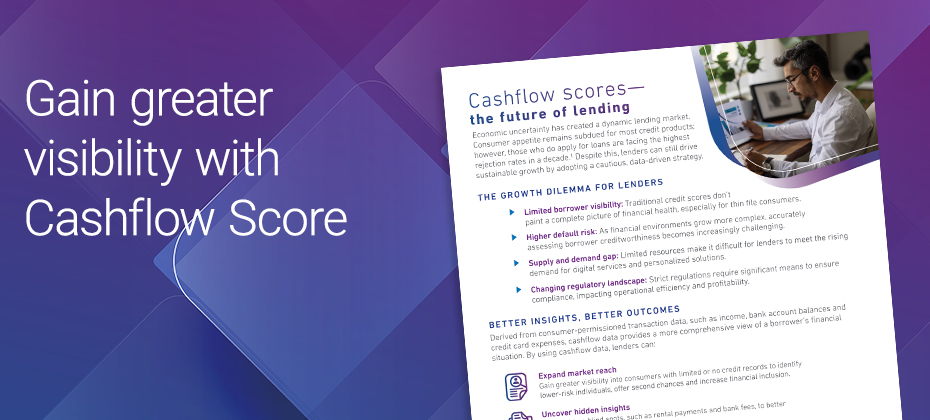
From chatbots to image generators, artificial intelligence (AI) has captured consumers’ attention and spurred joy — and sometimes a little fear. It’s not too different in the business world. There are amazing opportunities and lenders are increasingly turning to AI-driven lending decision engines and processes. But there are also open questions about how AI can work within existing regulatory requirements, how new regulations will impact its use and how to implement advanced analytics in a way that increases equitable inclusion rather than further embedding disparities.
How are lenders using AI today?
Many financial institutions have implemented — or at least tested — AI-driven tools throughout the customer lifecycle to:
- Target the right consumers: With tools like Ascend Intelligence ServicesTM Target (AIS Target), lenders can better identify consumers who match their credit criteria and send right-sized offers, which enables them to maximize their acceptance rates.
- Detect and prevent fraud: Fraud detection tools have used AI and machine learning techniques to detect and prevent fraud for years. These systems may be even more important as new fraud risks emerge, from tried-and-true methods to generative AI (GenAI) fraud.
- Assess creditworthiness: ML-based models can incorporate a range of internal and external data points to more precisely evaluate creditworthiness. When combined with traditional and alternative credit data*, some lenders can even see a Gini uplift of 60 to 70 percent compared to a traditional credit risk model.
- Manage portfolios: Lenders can also use a more complete picture of their current customers to make better decisions. For example, AI-driven models can help lenders set initial credit limits and suggest when a change could help them increase wallet share or reduce risk. Lenders can also use AI to help determine which up- and cross-selling offers to present and when (and how) to reach out.
- Improve collections: Models can be built to ease debt collection processes, such as choosing where to assign accounts, which accounts to prioritize and how to contact the consumer.
Additionally, businesses can implement AI-powered tools to increase their organizations’ productivity and agility. GenAI solutions like Experian Assistant accelerate the modeling lifecycle by providing immediate responses to questions, enhancing model transparency and parsing through multiple model iterations quickly, resulting in streamlined workflows, improved data visibility and reduced expenses.
WATCH: Explore best practices for building, fine-tuning and deploying robust machine learning models for credit risk.
The benefits of AI in lending
Although lenders can use machine learning models in many ways, the primary drivers for adoption in underwriting include:
- Improving credit risk assessment
- Faster development and deployment cycles for new or recalibrated models
- Unlocking the possibilities within large datasets
- Keeping up with competing lenders
Some of the use cases for machine learning solutions have a direct impact on the bottom line — improving credit risk assessment can decrease charge-offs. Others are less direct but still meaningful. For instance, machine learning models might increase efficiency and allow further automation. This takes the pressure off your underwriting team, even when application volume is extremely high, and results in faster decisions for applicants, which can improve your customer experience.
Incorporating large data sets into their decisions also allows lenders to expand their lending universe without taking on additional risk. For example, they may now be able to offer risk-appropriate credit lines to consumers that traditional scoring models can’t score.
And machine learning solutions can increase customer lifetime value when they’re incorporated throughout the customer lifecycle by stopping fraud, improving retention, increasing up- or cross-selling and streamlining collections.
Hurdles to adoption of machine learning in lending
There are clear benefits and interest in machine learning and analytics, but adoption can be difficult, especially within credit underwriting. A recent Forrester Consulting study commissioned by Experian found that the top pain points for technology decision makers in financial services were reported to be automation and availability of data.
Explainability comes down to transparency and trust. Financial institutions have to trust that machine learning models will continue to outperform traditional models to make them a worthwhile investment. The models also have to be transparent and explainable for financial institutions to meet regulatory fair lending requirements.
A lack of resources and expertise could hinder model development and deployment. It can take a long time to build and deploy a custom model, and there’s a lot of overhead to cover during the process. Large lenders might have in-house credit modeling teams that can take on the workload, but they also face barriers when integrating new models into legacy systems. Small- and mid-sized institutions may be more nimble, but they rarely have the in-house expertise to build or deploy models on their own.
The models also have to be trained on appropriate data sets. Similar to model building and deployment, organizations might not have the human or financial resources to clean and organize internal data. And although vendors offer access to a lot of external data, sometimes sorting through and using the data requires a large commitment.
How Experian is shaping the future of AI in lending
Lenders are finding new ways to use AI throughout the customer lifecycle and with varying types of financial products. However, while the cost to create custom machine learning models is dropping, the complexities and unknowns are still too great for some lenders to manage. But that’s changing.
Experian built the Ascend Intelligence Services™ to help smaller and mid-market lenders access the most advanced analytics tools. The managed service platform can significantly reduce the cost and deployment time for lenders who want to incorporate AI-driven strategies and machine learning models into their lending process. The end-to-end managed analytics service gives lenders access to Experian’s vast data sets and can incorporate internal data to build and seamlessly deploy custom machine learning models. The platform can also continually monitor and retrain models to increase lift, and there’s no “black box” to obscure how the model works. Everything is fully explainable, and the platform bakes regulatory constraints into the data curation and model development to ensure lenders stay compliant.
* When we refer to “Alternative Credit Data,” this refers to the use of alternative data and its appropriate use in consumer credit lending decisions as regulated by the Fair Credit Reporting Act (FCRA). Hence, the term “Expanded FCRA Data” may also apply in this instance and both can be used interchangeably.


